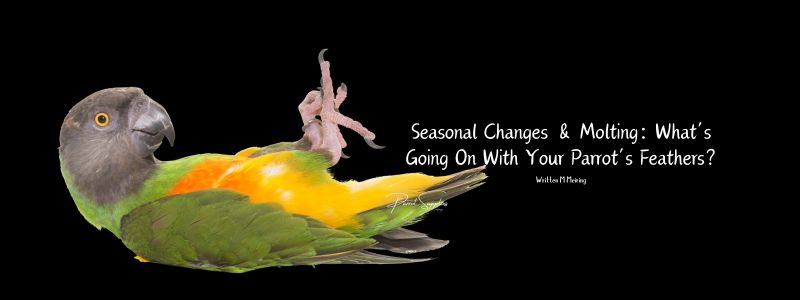Seasonal Changes & Molting: What’s Going On With Your Parrot’s Feathers?
As the seasons change in sunny South Africa, you might notice a flurry of feathers floating around the cage — no, your parrot isn’t redecorating. It’s molting season! Understanding how molting works, why it happens, and how to support your bird through it is key to keeping your feathered friend healthy, comfy, and fabulous.
Let’s break it down — feather by feather.
What is Molting & Why Does It Happen?
Molting is the natural process of feather renewal. Just like we lose dead skin cells or hair, parrots shed old feathers to make way for fresh, strong ones.
Feathers wear down from daily use — flying, playing, preening, even cuddling. A healthy molt ensures your bird’s feathers stay weatherproof, flight-ready, and beautiful.
But why now?
Molting often coincides with seasonal changes, particularly spring and autumn. These shifts in daylight and temperature act as biological signals for birds, especially those living near natural light patterns.
Even indoor parrots, influenced by household lighting and window views, may follow this rhythm. So as the South African days grow longer or shorter — voilà! Your parrot’s wardrobe gets a seasonal refresh.
🧭 Signs Your Parrot Is Molting
Molting can look dramatic, but it’s usually nothing to worry about. Here’s what you might notice:
- Loose or dropped feathers daily (especially flight and tail feathers)
- New feather growth (called blood feathers — dark quills with visible blood supply)
- A grumpy or sleepy parrot (molting can be uncomfortable and energy-zapping)
- Reluctance to be touched, especially around the head and neck
- Increased preening as they manage new feathers
- Patchy appearance, especially in heavy moulters like African Greys or Cockatoos
💡 Tip: Keep an eye on where feathers are lost — even molts should be symmetrical.
🚩 Molting vs Illness: How To Tell the Difference
Molting is natural — but illness isn’t. Here’s how to tell them apart:
Molt or Illness? Here’s How to Tell
|
Molting |
Illness |
|
Gradual, even feather loss |
Sudden or patchy loss |
|
Slightly low energy but responsive |
Lethargic, puffed-up, reduced appetite |
|
Appetite okay |
Eats/drinks very little or not at all |
|
Stable weight |
Noticeable weight loss |
|
Normal droppings |
Changes in colour, consistency, smell |
If you’re unsure, contact an avian vet. It’s better to be safe than sorry!
🧪 Molting Support: Supplements & TLC
Feather regrowth takes serious nutrients: amino acids (the building blocks of keratin), vitamins (like A, D, E), minerals (like zinc), and trace elements.
That’s where a good supplement can make all the difference. Enter…
⭐ PREMOLT 5 from MedPet
A specially formulated supplement for single cage birds (like many companion parrots), PREMOLT 5 delivers essential support right when your parrot needs it most.
🌟 Why it’s great:
- Aids feather development and regrowth
- Supports metabolism during the energy-demanding molt
- Improves feather quality for that glossy, showbird finish
- Helps reduce the risk of feather plucking, often triggered by discomfort or nutritional gaps
🧴 How to use it:
Follow dosing instructions provided on the label or by your avian vet. It’s best used throughout the molt or as a proactive measure during seasonal shifts.
💡 Extra Molting Tips from the Flock
- Humidity helps: Dry indoor air can irritate skin. Light misting or a gentle bath helps soften sheathes on new feathers.
- Molting toys: Offer soft shreddables and preening toys — especially helpful for itchy birds who need an outlet.
- Protein boost: If your bird’s diet is pellet-based, great! Add small amounts of egg food, sprouts, or legumes during heavy molts for extra amino acids.
- Hands off the head: Those pin feathers look tempting to help with… but trust us, unless your bird asks, let them do it themselves.
- Be kind: Molting birds can be sore and moody. Keep routines gentle and avoid major training changes.
📉 When Things Go Awry: Abnormal Molting
Call your vet if you notice:
- Bald patches that don’t regrow
- Bloody or broken feather shafts
- Plucking (self-inflicted or from a cage mate)
- Repeated molts without seasonal cues
- Stress bars — visible lines across feathers showing interrupted growth
Molting is seasonal. Chronic feather loss could signal diet issues, stress, parasites, or medical conditions.
🐦 Quick Summary
- Molting is a healthy, seasonal process triggered by changes in light and weather.
- Expect loose feathers, new growth, and some grumpiness.
- Support your parrot with nutrients, gentle care, and space to preen.
- Use PREMOLT 5 to help them grow strong, healthy feathers.
- When in doubt, consult an avian vet.
Want to give your bird a smoother molt?
Shop PREMOLT 5 and other vet-approved support at https://parrotsupplies.co.za.
Questions? Email us at info@parrotsupplies.co.za — we’re happy to help you and your floof.
📚 References
- Harrison, G. & Lightfoot, T. (2006) — Clinical Avian Medicine — https://avianmedicine.net
- Becker, M. (2020) — Seasonal Changes and Molting in Pet Birds — Merck Veterinary Manual
- MedPet — Premolt 5 Product Sheet — https://medpet.co.za
- Roudybush Nutrition — Feather Health & Nutrition — https://roudybush.com
- Association of Avian Veterinarians — Feather Disorders — https://aav.org

